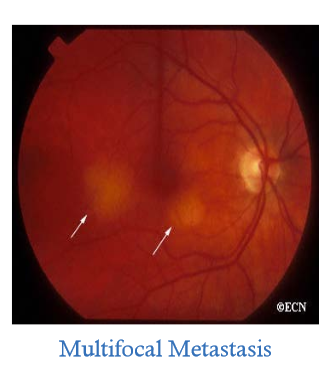 When cancer metastasizes to the eye and the orbital area, early detection, diagnosis, and prompt treatment offer the best chance to preserve vision.
When cancer metastasizes to the eye and the orbital area, early detection, diagnosis, and prompt treatment offer the best chance to preserve vision.
The most common sources of ocular metastasis are breast cancer, primarily in women, followed by lung cancer, primarily in men. However, other less common sources include gastrointestinal, prostate, lymphoid, leukemia, thyroid, kidney, and skin (primarily melanoma).
Choroidal metastases occur in up to 10% of patients with systemic metastatic disease (more than one organ). However, few of these patients are ever diagnosed. This is because most ocular metastases are occult, asymptomatic and do not cause loss of vision. Sophisticated imaging techniques are required to detect these metastases.
However, when intraocular metastasis affect the central retina (macula), optic nerve or front of the eye (iris), it causes changes in vision, vision loss or glaucoma. Similarly, orbital metastases can compress the optic nerve or push the eye forward (proptosis) leading to corneal exposure damage. As a result, ocular metastases are emergency situations that require prompt treatment.
For more detailed information on the diagnosis and treatment of metastasis to the eye and orbital area, download the PDF:









